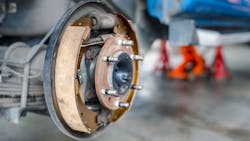The return of drum brakes: Could the auto industry see the resurgence of the historic braking system?
The automotive industry is undergoing a monumental shift toward electric vehicles, placing a renewed emphasis on sustainability. Sustainability goals outlined by world governments and supported by industry leaders means investments and resources are being funneled toward reducing emissions. In fact, brake dust, a major source of vehicle emissions, is under the microscope in the fight to reduce emissions – and an unlikely braking system could play a role in addressing it.
Most sustainable solutions require new or innovative technologies – but could there be a case for drum brakes, a long-surpassed braking solution, to be implemented on passenger vehicles going forward?
Drum brakes were first developed in France in 1902 and quickly became a standard brake solution for passenger automobiles due to decent performance and inexpensive cost. However, as new safety measures were implemented in the ‘50s and ‘60s, most drum brakes began to be phased out of passenger vehicles in favor of the disc brake. Although more expensive to produce, disc brakes offer better stopping power, especially important for the heavier cars of that era. Disc brakes were also a more reliable option as they were better equipped for drivers who were taking longer and more frequent trips.
Brake dust is contained within a drum brake, reducing pollution
However, the open-air design of the disc brake leaves much to be desired from an emissions-reduction standpoint – thus making room for the potential return of drum brakes.
When it comes to environmental impact, brake dust – or small particulate matter that is produced during the braking application – contributes up to 20 percent of overall fine particulate matter traffic pollution. It’s a considerable amount, knowing that exhaust fumes contribute 7 percent. It’s not just harmful to the environment; brake dust can actually lead to inflammation and impair the body’s ability to fight off bacteria.
Brake dust is created from the friction used to stop the wheels. Disc brakes, for example, use clamping or pushing motions to create that friction, whereas drum brakes use brake shoes fitted with brake linings (the friction material) to press against the brake drums from the inside in order to stop the car.
The inherent design of drum brakes ensures that most of the brake dust that’s produced is caught in the drum — allowing the vehicle owner or technician the ability to clean the brake with a soft bristled brush or wheel washcloth — though the drums aren’t a perfect system, as some of the particulate matter can get into the air. However, it’s more effective at limiting brake dust emissions than is the disc brake.
Outside of the sustainability elements, drum brakes do offer certain advantages over disc brakes as they are generally cheaper to manufacture, require low input force to be activated and are slightly easier to maintain since there’s better corrosion resistance. These advantages, along with an increased focus on sustainability, make a solid case for implementing drum brakes on modern ICE and electric vehicles.
Drum brakes are a great option for electric vehicles and hybrids, as they can work in tandem with regenerative braking, which slows the car down and captures kinetic energy. Additionally, the drum brake’s lack of drag makes it a great braking solution for EVs and hybrids.
Another signal of the potential return for drum brakes is the proposed Euro 7 standards — set to begin in 2035 — which call for the need to reduce brake emissions by 27 percent.
Cautious outlook for drum brake resurgence
That said, there’s a long way to go before drum brakes return to modern vehicles. Disc brakes offer better performance, are more reliable during high-braking conditions (e.g. going downhill) and are easier to service. For instance, many modern disc brake solutions are designed for maximum durability and consistent wear, which prolongs the lifespan of the brake systems. These advantages position disc brakes as the optimal brake systems for front wheels. In fact, the Volkswagen ID.4 Electric crossover has rear drum brakes, but disc brakes on the front wheels.
The case for drum brakes is set to get stronger as we see OEMs and policymakers take steps to address emissions on passenger vehicles. The argument is bolstered even more when considering the emissions reduction capabilities, the cost advantage and ease of use in vehicles. While drum brakes may not be a perfect solution, their potential return could provide significant benefits to automakers striving to achieve vehicle emissions goals as the brake system’s drum design can capture brake dust and can be easily cleaned and discarded. The stopping power and overall performance of disc brakes cannot be understated, and any implementation of drum brakes will be limited.
Automakers' adaptability and innovation in refining drum brake technology will be a key aspect to watch in the future. They may focus on enhancing drum brakes' design, exploring new materials, or integrating advanced electronic systems to further improve their performance. Alternatively, the industry might witness the exploration of cutting-edge braking technologies, potentially revolutionizing braking efficiency and emissions reduction. The race to find the optimal braking system will not only drive competition among manufacturers but will also shape the industry's journey toward a more sustainable automotive landscape.



